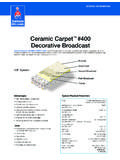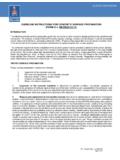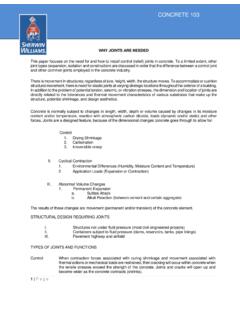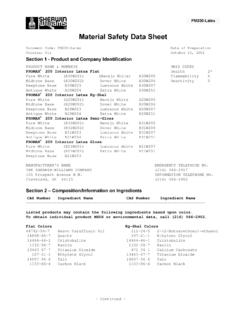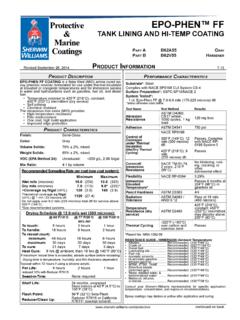Transcription of Topcoat Body/Fill Coat Primer - General Polymers
1 system INFORMATIONSTATIC DISSIPATIVECOATING system #18 SDGeneral Polymers static dissipative coating system #18 SD is comprised of a conductive water-based epoxy Primer and aliphatic urethane Topcoat . Conforms to ANSI for ESD protectionAdvantages Epoxy Primer provides aggressive bond to substrate Color stability Superior gloss retention Resists certain aggressive chemicals EconomicalUses Electronics production Clean rooms Computer rooms Aircraft hangarsTypical Physical PropertiesColor 4620E Standard Colors Conductivity Resistance <109 Charge Decay Dissipates a 5,000 volt MIL-B-81705B charge to zero in less than seconds Abrasion Resistance 100 mg lostASTM D 4060 Compressive Strength 8,500 psiASTM D 695 Tensile Strength 2.
2 500 psiASTM D 638 Flexural Strength 10,000 psiASTM D 790 Hardness, Shore D 75/70 ASTM D 2240 Adhesion 300 psiACI 503R concrete failureFlammability Self-extinguishing over concreteGloss Meter 60 4620E 80-100 pts. ASTM C = Mortar SystemASTM D = Resin onlyTopcoatBody/Fill CoatPrimerInstallationThe following information is to be used as a guideline for the instal-lation of the static dissipative coating system #18 the Technical Service Department for assistance prior to Preparation GeneralGeneral Polymers systems can be applied to a variety of substrates, if the substrate is properly preapred.
3 Preparation of surfaces other than concrete will depend on the type of substrate, such as wood, concrete block, quarry tile, etc. Should there be any questions regarding a specifi c substrate or condition, please contact the Technical Service Department prior to starting the project. Refer to Surface Preparation Form (G-1).Surface Preparation ConcreteConcrete surfaces shall be abrasive blasted to remove all surface contami-nants and laitance. The prepared concrete shall have a minimum surface profi le equal to 40-60 grit initial preparation has occurred, inspect the concrete for bug holes, voids, fi ns and other imperfections.
4 Protrusions shall be ground smooth while voids shall be fi lled with a General Polymers system fi ller. For recommendations, consult the Technical Service the application process, substrate temperature should be 50 F - 90 F. Substrate temperature must be at least 5 F above the dew point. Ap-plications on concrete substrates should occur while temperature is falling to lessen off gassing. The material should not be applied in direct sunlight, if InformationVOC MIXEDMATERIALMIX RATIOTHEORETICAL COVERAGE PER COAT CONCRETEPACKAGING<50 g/LConductive pints water per gallon kit4:1250 sq.
5 Ft. / - 25 gals<10 g/LBody/Fill Coat35643:1130-200 sq. ft. / gal4 or 20 gals<10 g/LTopcoat4620E2:1300-333 sq. ft. / gal3 or 15 galsConductive PrimerMixing and Application1. Premix 3424A (hardener) and 3424B (resin) separately, using a low speed drill and Jiff y blade Mix for one minute and until uniform, exercising caution not to whip air into the Add 4 parts 3424A (hardener) to 1 part 3424B (resin) by volume. Mix with low speed drill and Jiff y blade for three minutes and until uniform. 3424 must be reduced 10-15% with potable water to improve fl ow and leveling. DO NOT reduce product until after both components have been mixed together for 90 seconds, Mix side A and side B minimum of 90 seconds, then MUST pints water per gallon kit.
6 Reduction water must be added after A side and B side is mixed fi using a short nap roller at a rate of 250 - 320 square feet per gallon (5-6 WFT mils).4. Inspect Primer coat prior to application of system . Test surface resistance in accordance with NFPA 99. Resistance range should be less than 150,000 ohms. If deviation from this range occurs, consult the Technical Service Department immediately. Body Coat/Fill Coat (3564)Mixing and Application1. Premix 3564A (resin) using a low speed drill and Jiff y blade. Mix for one minute and until uniform, exercising caution not to whip air into the Add 3 parts 3564A (3 quarts resin) to 1 part 3564B (1 quart hardener) by volume.
7 Mix with low speed drill and Jiff y blade for three minutes and until Apply material via brush, roller or squeegee at a spead rate of 130-200 sq. ft. per gallon to yield 8-12 mils WFT. This material must be sanded or abraded prior to topcoating if allowed to cure more than 24 hours Topcoat (4620E)Mixing and Application1. Premix 4620EA (resin) using a low speed drill and Jiff y blade. Mix for one minute and until uniform, exercising caution not to whip air into the Add 2 parts 4620EA (resin) to 1 part 4620B (hardener) by volume. Mix with low speed drill and Jiff y blade for three minutes and until uniform.
8 Ap-ply material via airless spray or roller at a spread rate of 300-333 sq. ft. per gallon to yield 5 mils WFT. 3. Allow to cure 24 hours minimum before opening to light foot traffi EquipmentBrush / RollerUse 1/4 phenolic core rollers and professional quality, medium stiff natural bristle Control FloorsStatic control fl ooring can be defi ned as a fl ooring system that can drain and/or dissipate static charges by grounding personnel, equipment or other objects contacting the fl oor surface or that controls the generation and accumulation of static charges. The resistance to the movement of electrons across the material s surfaces defi nes static control fl oorings into the following two categories:i) Conductive Floor has a resistance of x 104 -106 ohms per 3 ft.
9 It can drain static charge dissipating a 5,000 - volt charge to zero in ) static dissipative Floor has a resistance of <109 ohms per 3 ft. It adds no static electricity to the environment and drains off a 5,000 - volt charge to zero in less than conductive fl oor has a much lower electrical resistance than a dissipative fl oor. It will carry the static charges to a ground quickly and effi ciently as to prevent accidental discharge and ignition. If the fl oor is too conductive, an operator on the fl oor can become too eff ectively grounded and will suff er electrical shock.
10 For this reason the NFPA requires all fl ooring surfaces to have a minimum resistance of 25,000 ohms. Frequent contact between tools and equipment, or dropping the tools on the fl oor, will cause spark and ignition. For those circumstances, a sparkproof conductive fl ooring system is highly recommended. The rapid rate of charge dissipation of conductive fl ooring can create a magnetic fi eld which can present a problem for manufacturers of electronic fl ooring systems have greater resistance to electric current fl ow than conductive fl oorings. At a working environment dealing with high test voltages, such as facilities where electronic components are manufactured or assembled, a dissipative fl oor should be installed so that the static charges can be gradually transferred to ground, protecting personnel from electrical shock while at the same time protecting sensitive electronic Flooring Measurement GuideThere are three test standards available for the evaluation of static dissipative or conductive fl oors and they are , ASTM F 150 and NFPA 99 (56A).



